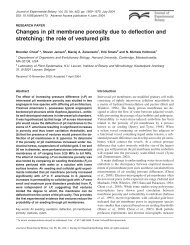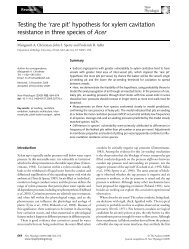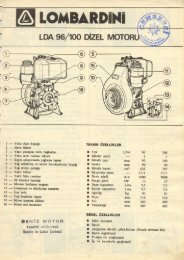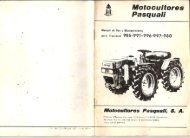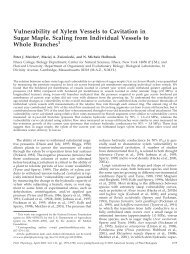View - ResearchGate
View - ResearchGate
View - ResearchGate
Create successful ePaper yourself
Turn your PDF publications into a flip-book with our unique Google optimized e-Paper software.
88 A. Vilagrosa et al.have evolved: building up new functional conduits and refilling of embolized onesthrough an active mechanism. The first mechanism is common to almost terrestrialplant species with secondary cambium for which the production of new conduitsincreases overall xylem functionality. Recovery from embolism is based solely onthis mechanism in several tree species (Cochard et al. 2001). The second mechanismimplies a refilling of air-filled conduits when the xylem water potential isnear or above the atmospheric value (Tyree and Yang 1992; Tyree et al. 1999).However, recent observations indicate the occurrence of embolism removal evenin the presence of negative pressures in the xylem (Holbrook and Zwieniecki 1999;Salleo et al. 2006) associated with osmosis rather than the mechanically expectedpotential in intact woody plants, a none-straightforward mechanism which seemsto violate the laws of thermodynamics (Clearwater and Goldstein 2005; Tyreeet al. 1999). Moreover, for the former authors, many of the major biophysicalquestions regarding refilling under tension remain unanswered.Since understanding how embolism repair under tension occurs is critical forevaluating the costs and constraints of transporting water in a metastable state,Zwieniecki and Holbrook (2009) devoted a conceptual framework as a guidelinefor future studies to understand how xylem refilling under tension takes place.Recently, Brodersen et al. (2010) reported a breakthrough in xylem embolismrepair under tension based on experimental observations and theoretical modeling.Using the potential of 3D high-resolution computed tomography for in vivomonitoring of embolism repair, they visualized water droplets apparently exitingfrom vasicentric cells and entering embolized vessels of Vitis vinifera. Thedroplets expand over time and refill vessels while forcing the dissolution ofentrapped gases at substantially negative stem water potentials ranging between -0.45 and -0.75 MPa (see Nardini et al. 2011 for review). Yet, embolism repairunder negative pressure continues to be an unanswered question since it isrestricted to a few number of species investigated.3.3.5 Cavitation Plasticity: Variations Within the Tree,Populations, Ecotypes, or CultivarsCavitation resistance, at the interspecific level, has been widely documented acrossspecies and varies considerably (Maherali et al. 2004; Bréda et al. 2006). Comparisonsof more or less distantly related taxa growing in contrasting environmentssuggest that increased cavitation resistance is a key component of species growingin drought-prone habitats (Tyree and Ewers 1991; Hacke et al. 2000; Pockman andSperry 2000). To date, Machado and Tyree (1994) report similar levels of droughtinducedcavitation in deciduous and evergreen plants, but higher levels in tropicalplants than in temperate forest species. Even, reports are much scarcer at theintraspecific level, resistance to cavitation can vary significantly between populationsof the same species (Alder et al. 1996; Herbette et al. 2010; Wortemann





